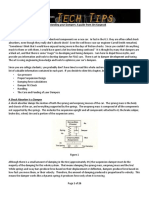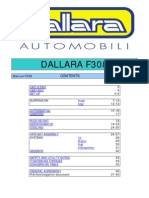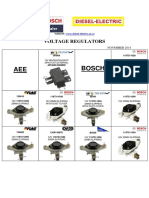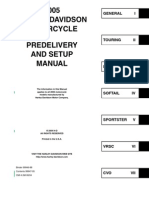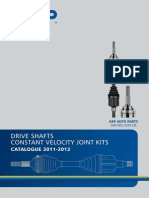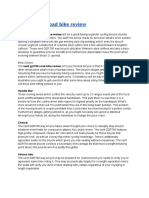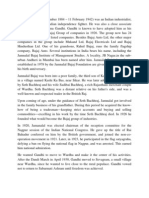Suspension Set Up Explained: The Components, Where Are They and What Do They Do
Suspension Set Up Explained: The Components, Where Are They and What Do They Do
Uploaded by
af00712210Copyright:
Available Formats
Suspension Set Up Explained: The Components, Where Are They and What Do They Do
Suspension Set Up Explained: The Components, Where Are They and What Do They Do
Uploaded by
af00712210Original Title
Copyright
Available Formats
Share this document
Did you find this document useful?
Is this content inappropriate?
Copyright:
Available Formats
Suspension Set Up Explained: The Components, Where Are They and What Do They Do
Suspension Set Up Explained: The Components, Where Are They and What Do They Do
Uploaded by
af00712210Copyright:
Available Formats
Suspension Set Up Explained
The components, where are they and what do they do.
A Fork Rebound Damping
Usually located on top of the fork in the center of the preload adjuster. Controls the extension of the fork after it compresses. Screw in for firmer/ quicker extension and out for softer/ slower extension. Use a screwdriver to adjust. Turn in all the way and then turn out and listen for the clicks. If you have a ten-way adjustment it will have ten clicks. First click out, firmest setting, tenth click out, softest.
If you don't have any adjustment you can alter the firmness by the weight of the shock oil. You can also adjust the firmness by changing the springs inside the fork. You should adjust the front fork preload, rebound, and compression settings equally/ by the same percent or close to it, if youre not sure exactly what youre doing. Always make sure the right and left fork are adjusted exactly equal.
B Fork Preload
Located on top of the fork and can be adjusted using a socket or wrench. Preload is the amount you compress the front fork spring from its normal state. The more preload/ the more you compress the spring. The stiffer the fork becomes. The preload adjustment settings can be seen by the circular rings or marks. If you have a five-way adjustment it will have five marks. One mark showing is the stiffest setting. Five marks showing is the softest setting. Preload adjustments generally make the most noticeable change to the front fork stiffness or the amount the bike dips forward under heavy braking.
Fork Compression Damping If you have this adjustment it is usually located at the bottom of fork. It controls the compression of the fork when it hits a bump. Screw in for firmer/ slower compression and out for softer/ faster compression. Use a screwdriver to adjust. Turn in all the way and then turn out and listen for the clicks. If you have a ten-way adjustment it will have ten clicks. First click out, firmest setting, tenth click out, softest.
Not all bikes have this adjustment, and some have it linked to the rebound damping. You should adjust the front fork preload, rebound, and compression settings equally/ by the same percent or close to it, if youre not sure exactly what youre doing. Always make sure the right and left fork are adjusted exactly equal.
A Rear Compression Damping
Instead of at the bottom of the shock like the front forks, the rear compression damping adjustment will be at the top of the rear shock. It will be on a remote reservoir connected to the top of the shock like the photo to the left. It may also be connected by a hose and the reservoir located under the seat or slightly above and to the side of the rear shock.
It controls the compression of the rear when it hits a bump. Screw in for firmer/ slower compression and out for softer/ faster compression. Use a screwdriver to adjust. Turn in all the way and then turn out and listen for the clicks. If you have a ten-way adjustment it will have ten clicks. First click out, firmest setting, tenth click out, softest. You should adjust the rear preload, rebound, and compression settings equally/ by the same percent or close to it, if youre not sure exactly what youre doing. B- Rear Preload Adjusting the rear preload will usually make the biggest difference in the handling of your bike. Unfortunately it is also the most difficult adjustment to make to the rear suspension. The rear preload is the amount the rear spring is pre -compressed. The tighter the spring is compressed, the stiffer the rear suspension becomes, and the higher the rear end of the bike will sit. This rear height change will put more of the bikes weight on the front, affecting the handling. To adjust the rear preload you will need a C-spanner which is a large C shaped wrench. You can use a hammer and punch or dowel, but this may damage the adjustment ring nuts. First loosen the top ring nut separating it from the bottom ring nut. Now you can tighten and loosen or move the bottom ring nut up and down. Up will decrease/ soften the preload and down will increase/ stiffen the preload. Once you have the bottom ring nut where you want it, tighten the top ring nut to the bottom. Be careful not to over tighten the ring nuts together and strip them. Small adjustments to the rear preload will make a big difference. If you do not have two ring nuts for adjustments you may have a metal ring located above the spring on the shock, that has step adjustments on the ring. To adjust this you may first have to loosen a locking screw on the ring if there is one. Then move the ring to the left or right to adjust the preload. Remember to tighten the locking screw.
Rear Rebound Damping Usually located on the bottom of the rear shock unlike the front fork adjustment. Controls the extension of the fork after it compresses. Screw in for firmer/ quicker extension and out for softer/ slower extension. Use a screwdriver to adjust. Turn in all the way and then turn out and listen for the clicks. If you have a ten-way adjustment it will have ten clicks. First click out, firmest setting, tenth click out, softest. Some bikes have a knob that you turn left or right to make the adjustment, but it still makes clicks. You should adjust the rear preload, rebound, and compression settings equally/ by the same percent or close to it, if youre not sure exactly what youre doing.
Rear Ride Height Adjustment Some bikes will have a rear ride height adjustment. It may be a screw coming out of the top of the rear shock, like in the photo to the left, or it may be a screw coming out of the bottom of the rear shock. Both adjust in a similar way. If you adjust the ride height of the bike you will also change the weight distribution of the bike. Raising the rear will put more weight on the front. This will cause the bike to turn in quicker or easier, but can make the rear unstable or cause tank slappers. If you notice these negative side effects increasing the front preload may be the solution. A raised rear, weight forward adjustment is usually best for track situations, but not everyday riding, so they say. To adjust the rear ride height loosen the nut on the bolt farthest away from the shock. Then adjust the closer nut raising or lowering the rear. Finally tighten the farther nut. You can also adjust the ride height by lowering the front triple clamps on the front forks. However that is fairly more difficult, and should only be done by someone who knows what they are doing. Since a very small adjustment up front can make a huge difference.
Static Sag - Suspension Travel This is a way of adjusting your suspension by measuring the amount it compresses with the full weight of the rider on it. Your front and rear suspension should sag an equal amount. The general rule is that your sag should take up the first third of your suspension travel. Front and rear preload are the two main adjustments in this technique to get the correct sag. Then dial in the other adjustments for fine-tuning. Some people swear by this technique even though it's a pain. Just follow the instructions below. 1. Put on the gear you normally ride in to get the weight correct. 2. Find two friends to help you measure and hold the bike. 3. Without you on the bike, extend the front fork completely. Measure to the seal wiper to the triple clamp, or to the axel clamp for an inverted fork. This measurement is "S1" 4. Sit on the bike in your normal riding position with your feet on the pegs. Have your friend hold the bike from the rear vertical/ centered. Now have your other friend push down on the front forks, let go and let the forks extend slowly. Take the same measurement you took above again. This measurement is "S2" 5. Finally have your friend at the front of the bike pull up on the forks, let go, and then settle slowly. Once again take the same measurement you took above. This measurement is "S3" 6. Now calculate the sag using this formula "Sag=S1- (S3+S2)/2" Confused? If not repeat the above steps for the rear sag, taking your measurements from the rear axle to a point directly above, like in the photo.
Common Suspension/ Handling Problems
Your Bike Bottoms Out Symptoms: When you brake hard into a turn or at a stoplight the front end seems to dive down or bottoms out. You accelerate hard and the front of the bike rises up and the back squats down, like a boat. Entering a turn at speed the back or front of the bike feels like it drops significantly and then becomes unstable when get back on the gas. When you hit a bump you get an extreme double bounce from the front and then the back. Solution: You need more preload. If you notice the symptoms on the front increase the front preload, if the rear, rear preload. Do one at a time and then test it out. One out of adjustment can give the feel of both being out. When you change the preload adjustments you will also be affecting the bikes ride height, which will affect the handling. So if you stiffen the front preload and not the back, the front of your bike will raise. This will cause you to notice that the bike doesn't turn into the turns as easily as before. To correct this and keep the same rear preload adjust the rear ride height or lower the front by raising the fork tubes in the triple clamps. Adjusting the front ride height by the triple clamps can be tricky and needs to be done in very small increment, 4mm at a time or so. Your Bike Feels Bouncy Symptoms: It's a sport bike but it feels more like a Goldwing. Your suspension is soft and comfy,
but feels bouncy. When you get into the twisties the bike has a floating feeling that makes road feedback vague at high speeds. The bike seems to bend in the middle. Solution: Increase/ stiffen the rebound damping to dissipate the increased bump forces at higher speeds. Adjust the front and the rear independently, testing the changes as you go. Your Bike Has A Rough Feeling Ride Symptoms: When your bike goes over rough road it doesn't seem to absorb the bumps at all. Bumps seem to hit the bike hard and quick, like a pothole. After riding for a while youre sore because your bike isn't properly absorbing the bumps its passing them on to you. Solution: You should first try and reduce rear compression damping. In bad cases your overall setup may be too stiff and you should reduce compression and rebound damping both. Your Bike Under steers Or Feels Vague Symptoms: When exiting a turn you start to get back on the throttle and the front tends to slid or wash out. On slightly uneven or bumpy roads the front tire feedback goes away and the returns for a second just to go away again. The steering may also feel a bit heavy. Solution: Reduce front fork preload. The front tire is not moving down fast enough and the ride height is probably to high up front. Reducing preload will lower the front and let the forks expand quicker. You Bikes Bars Violently Twitch Back And Forth - A Tankslapper! Symptoms: When accelerating the front wheel shakes back and forth quickly. In extreme cases the bars can almost pull out of your hands or if you hold on tight throw you back and forth on the bike and then cause the back to skip left and right. This is a tankslapper. The bars might also twitch mid-corner or feel unstable on turn in. The bike turns into corners to easily. Solution: Increase front fork preload or lower the rear ride height. You have too much weight on the front tire. Your Bikes Rear End Feels Wiggly, Or Breaks Loose Easily Symptoms: You get on the brakes hard for that tight left hander and the back tire skids or wiggles side to side. Solution: Increase front fork rebound and preload. You could also lower the rear ride height slightly Your Back Tire Feels Like It's Flat Symptoms: Your rear tire feels vague or like it has a slight side-to-side wiggle, similar to a flat rear tire. You've checked your air pressure and it's not low. Solution: Increase rear spring preload. This will stiffen the back for a more solid feel and slow down rear form rising to quickly.
You might also like
- Derbi Senda Service Manual DRD ModelDocument71 pagesDerbi Senda Service Manual DRD ModelChris Ranger Richardson86% (7)
- OvalCrewChief101 v5Document7 pagesOvalCrewChief101 v5darakof258No ratings yet
- The Perfect Corner 2: A Driver's Step-by-Step Guide to Optimizing Complex Sections Through the Physics of RacingFrom EverandThe Perfect Corner 2: A Driver's Step-by-Step Guide to Optimizing Complex Sections Through the Physics of RacingNo ratings yet
- Setup Guide For High-Downforce Cars v1.3 PDFDocument18 pagesSetup Guide For High-Downforce Cars v1.3 PDFJefferson Junior100% (3)
- Redline ProductsLDocument2 pagesRedline ProductsLflanker_13No ratings yet
- Volta 1.2Document10 pagesVolta 1.2JozsefNo ratings yet
- Perfect Control: A Driver's Step-by-Step Guide to Advanced Car Control Through the Physics of RacingFrom EverandPerfect Control: A Driver's Step-by-Step Guide to Advanced Car Control Through the Physics of RacingNo ratings yet
- OptimunG Springs&Dampers Tech Tip 5Document2 pagesOptimunG Springs&Dampers Tech Tip 5Thomas MouraNo ratings yet
- Applied Vehicle Dynamics Seminar April 7-10, 2017 Sinhgad Technical Education Society - Pune, IndiaDocument2 pagesApplied Vehicle Dynamics Seminar April 7-10, 2017 Sinhgad Technical Education Society - Pune, IndiaPRAVEEN REDDY100% (1)
- Data Acquisition To Analyze The Driver and His Race CarDocument188 pagesData Acquisition To Analyze The Driver and His Race CarKelvin NyeNo ratings yet
- Race Setup FlowchartDocument1 pageRace Setup FlowchartEduardo Vallim100% (2)
- Tech Tip: Springs & Dampers, Part One: The Phantom KnowledgeDocument21 pagesTech Tip: Springs & Dampers, Part One: The Phantom KnowledgeHenrique CarstenNo ratings yet
- Ackerman Erik ZapletalDocument23 pagesAckerman Erik ZapletalMrudula Amar WardeNo ratings yet
- Setup by Topic PDFDocument1 pageSetup by Topic PDFBuddy FeyNo ratings yet
- Analysis of Change in Intake Manifold Length and Development of Variable Intake SystemDocument6 pagesAnalysis of Change in Intake Manifold Length and Development of Variable Intake SystemDarius TothNo ratings yet
- Vehicle Dynamics and Damping: First Revised EditionFrom EverandVehicle Dynamics and Damping: First Revised EditionRating: 4 out of 5 stars4/5 (2)
- OldsmobileDocument14 pagesOldsmobileAnonymous 4VqALyVv0% (1)
- Theoretical Background: How To Tune Your Dampers For Specific SituationsDocument7 pagesTheoretical Background: How To Tune Your Dampers For Specific Situationselpapy6100% (1)
- Setup Tips SuspensionDocument2 pagesSetup Tips SuspensionTripsZeeNo ratings yet
- Guide To Dyno GraphsDocument10 pagesGuide To Dyno GraphsRajaSekarsajjaNo ratings yet
- How To Set Up A Suspension (Time) HistogramDocument13 pagesHow To Set Up A Suspension (Time) HistogramAdy100% (1)
- Shock Speed ArticleDocument10 pagesShock Speed ArticleKathryn Workman100% (1)
- Chapter Four - Kinematic Steering - 2015 - Essentials of Vehicle DynamicsDocument11 pagesChapter Four - Kinematic Steering - 2015 - Essentials of Vehicle DynamicsJulián AvellaNo ratings yet
- Manual f300Document42 pagesManual f300Ignacio ManriquezNo ratings yet
- Quick Car Setup Guide Williams Toyota FW31Document8 pagesQuick Car Setup Guide Williams Toyota FW31maferioNo ratings yet
- Racecar Dynamics and Data Acquisition Training SeminarDocument4 pagesRacecar Dynamics and Data Acquisition Training Seminarmav87th-1No ratings yet
- Creating Tyre Models From NothingDocument9 pagesCreating Tyre Models From NothingSatvik VatsaNo ratings yet
- OptimunG Springs&Dampers Tech Tip 3Document4 pagesOptimunG Springs&Dampers Tech Tip 3Thomas Moura100% (1)
- F1 2016 Setup ManualDocument24 pagesF1 2016 Setup Manualdraq13No ratings yet
- J-Dampers in Formula OneDocument3 pagesJ-Dampers in Formula Onertech01No ratings yet
- Rouelle PPTDocument36 pagesRouelle PPTA Van Di100% (1)
- Advanced Formula 1 Setup GuideDocument54 pagesAdvanced Formula 1 Setup GuideSalty54No ratings yet
- Dampers - Racecar Engineering 2018-10-01 PDFDocument11 pagesDampers - Racecar Engineering 2018-10-01 PDFPaul Dumitru100% (1)
- OptimunG Springs&Dampers Tech Tip 4Document5 pagesOptimunG Springs&Dampers Tech Tip 4Thomas Moura100% (1)
- Making It Stick Part 1Document10 pagesMaking It Stick Part 1Ben HallamNo ratings yet
- Racecar DynamicsDocument14 pagesRacecar Dynamicsnemanjatopalovic1992No ratings yet
- A Guide To Your Dampers Chapter From FSAE Book by Jim Kasprzak UpdatedDocument26 pagesA Guide To Your Dampers Chapter From FSAE Book by Jim Kasprzak UpdatedPRAVEEN KUMARNo ratings yet
- Prototype Race CarDocument9 pagesPrototype Race Carznam100% (1)
- Damper Curves 2Document6 pagesDamper Curves 2Piyush DubeNo ratings yet
- Vehicle Dynamics ProDocument15 pagesVehicle Dynamics ProChirag D PatelNo ratings yet
- Tire Modeling and Friction Estimation - Jacob SvendeniusDocument194 pagesTire Modeling and Friction Estimation - Jacob SvendeniusEvangelos WhyshoulditellyoumynameNo ratings yet
- Bump SteerDocument5 pagesBump SteerHimanshu Rajput100% (2)
- Automotive Differentials, ReleaseDocument30 pagesAutomotive Differentials, Releasestefanovicana1No ratings yet
- F308manual v03Document40 pagesF308manual v03John McGillNo ratings yet
- Push - Rod Suspension System Used in F-1Document23 pagesPush - Rod Suspension System Used in F-1Ashish Rawat100% (1)
- Aerodynamic Features of Race CarsDocument18 pagesAerodynamic Features of Race CarskmssaileshNo ratings yet
- F 302 ManualDocument38 pagesF 302 ManualIgnacio Manriquez100% (1)
- Find Your Roll CenterDocument20 pagesFind Your Roll CenterchainplatesNo ratings yet
- Race Car Gear BoxDocument5 pagesRace Car Gear Boxmuhammad zia ur rehmanNo ratings yet
- Race Car Designing ProcedureDocument5 pagesRace Car Designing ProcedureBalaji AeroNo ratings yet
- Thesis Remco Advocaat 1275674Document131 pagesThesis Remco Advocaat 1275674Angel BorsaniNo ratings yet
- OptimunG Springs&Dampers Tech Tip 2Document3 pagesOptimunG Springs&Dampers Tech Tip 2Thomas MouraNo ratings yet
- FSAE Data Analysis Day 2 To PrintDocument55 pagesFSAE Data Analysis Day 2 To PrintJorge CorderoNo ratings yet
- Ackermann Steering For Performance Race Cars PDFDocument22 pagesAckermann Steering For Performance Race Cars PDFr2d23100% (1)
- Cosworth Data Bytes Live - Pi Toolbox v0 8Document41 pagesCosworth Data Bytes Live - Pi Toolbox v0 8Guilherme PfeilstickerNo ratings yet
- Dynamic Load TransferDocument15 pagesDynamic Load Transfermav87th-1100% (1)
- Slip Angle Explained Race Logic PDFDocument8 pagesSlip Angle Explained Race Logic PDFyeshwantambureNo ratings yet
- Motorcycle Cornering Behavior Modeling - PaperDocument14 pagesMotorcycle Cornering Behavior Modeling - PaperRafael DonadioNo ratings yet
- Brake Tech Tip PDFDocument4 pagesBrake Tech Tip PDFvijayakkannanNo ratings yet
- The Re-Design and Analysis of The Suspension System On The Formula Student Race CarDocument53 pagesThe Re-Design and Analysis of The Suspension System On The Formula Student Race CarPabloNo ratings yet
- V8 Supercar Case StudyDocument5 pagesV8 Supercar Case Studytushar girotraNo ratings yet
- Bike India-06 March - 2024Document100 pagesBike India-06 March - 2024msritNo ratings yet
- Ducati ConfiguratorDocument12 pagesDucati ConfiguratorArnnav MarwahNo ratings yet
- Lamborghini Urus ADWUBB 19.10.22Document19 pagesLamborghini Urus ADWUBB 19.10.22Rosazrom Argentina100% (1)
- Prov Result After Stage3Document6 pagesProv Result After Stage3PinkbikeNo ratings yet
- Brembo Catalogo PDFDocument116 pagesBrembo Catalogo PDFtd04gigs100% (1)
- Approved Motorcycles For Novice RidersDocument12 pagesApproved Motorcycles For Novice RidersBrettNo ratings yet
- Voltage Regulators November 2016Document16 pagesVoltage Regulators November 2016juanNo ratings yet
- IBEF Report Feb 2019Document27 pagesIBEF Report Feb 2019VKNo ratings yet
- Password List Brute ForceDocument40 pagesPassword List Brute ForceRandi Abdul100% (1)
- 2022 Partnership Opportunities - CompressedDocument27 pages2022 Partnership Opportunities - CompressedAdam CohenNo ratings yet
- Bachillerato Future TensesDocument2 pagesBachillerato Future TensesVane YesteNo ratings yet
- Tabela CarrosDocument78 pagesTabela CarrosroverosnpNo ratings yet
- Industrial Training Over Honda Motorcycle Engines: Diploma MechanicalDocument10 pagesIndustrial Training Over Honda Motorcycle Engines: Diploma MechanicalPAVAN KALYAN AMGOTHNo ratings yet
- VIN DECODER HarleyDocument2 pagesVIN DECODER HarleyorlyNo ratings yet
- Racing Helmet: From Wikipedia, The Free EncyclopediaDocument3 pagesRacing Helmet: From Wikipedia, The Free EncyclopediaPaklong AzhamNo ratings yet
- Merritt Morning Market 3136 - Apr 18Document2 pagesMerritt Morning Market 3136 - Apr 18Kim LeclairNo ratings yet
- NBC 446-ADocument18 pagesNBC 446-AjohnmalanaNo ratings yet
- Harley Davidson Pre Delivery and Set-Up 2005Document135 pagesHarley Davidson Pre Delivery and Set-Up 2005פטריה מוזר100% (1)
- Cooling Grill CatalogDocument62 pagesCooling Grill CatalogAnas KhanNo ratings yet
- CV Joints Drive Shafts 2011Document692 pagesCV Joints Drive Shafts 2011МарияКрутскихNo ratings yet
- UNIV143 Problem Spring 2020 5Document5 pagesUNIV143 Problem Spring 2020 5vqs87860No ratings yet
- 121 M NewDocument60 pages121 M Newjogeshwar raoNo ratings yet
- Kent Gzr700 Road Bike ReviewDocument1 pageKent Gzr700 Road Bike ReviewEliyzia BethNo ratings yet
- Raleigh Owners Guide PDFDocument52 pagesRaleigh Owners Guide PDFAndry Hernawan PrihanantoNo ratings yet
- Jamnalal BajajDocument9 pagesJamnalal Bajajmahesh_khebadeNo ratings yet




































